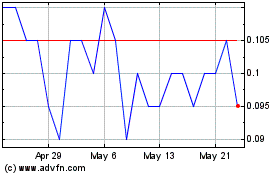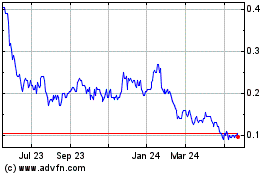Stallion Uranium Corp. (the
"Company" or
"Stallion") (TSX-V: STUD; OTCQB: STLNF; FSE: FE0)
is pleased to announce that the assay results have been received
from the winter 2024 drilling program. The assay results confirm
the presence of uranium in the intersected graphitic structure on
the Coffer uranium project in the Western Athabasca Basin,
Saskatchewan, Canada. The maiden drill program was focused on the
Appaloosa Target Zone with the preliminary results from each hole
reported in news releases on April 2, 2024, April 17, 2024 and May
7, 2024.
Highlights:
- Drillhole CF24-003 intersected anomalous uranium within the
graphitic structure, averaging 5 ppm U (uranium) and reaching a
maximum of 14 ppm U over a span of 94.7 meters.
- Elevated lead (Pb), nickel (Ni), arsenic (As) and uranium (U)
anomalies are located within the graphitic structure, which
correlate well to the known high grade, uranium mineralization
located at the Shea Creek deposits.
- The assay results are confirmation of the initial anomalous
radioactivity readings, confirming the presence of uranium-bearing
fluids within the identified alteration system.
- Outlined priority follow-up target area are shown in Figures
1.
“The assay results have confirmed initial
results as to the presence of uranium in the large conductive
structure intersected in the third drillhole at the Coffer
Project,” said VP, Exploration, Darren Slugoski. “The structure,
and zones of alteration, are substantial in size and have the
potential to host a large uranium deposit. Our model from all the
data collected during the drill program has identified multiple key
targets that give Stallion great potential to make a discovery. The
intersection of the graphitic conductor with the unconformity will
be a top priority target for our future drilling program.”
Figure 1 – Cross section of
CF24-003. The figure is an interpretation of the geological
structure with target area
Assay Results:
A total of 267 assay samples and 15 samples QAQC
samples were collected throughout the 2,798.2 meters completed in 3
drill holes and sent to the Geoanalytical Laboratory at the
Saskatchewan Research Council in Saskatoon for analysis. The third
and final hole of the inaugural drilling program intersected a
large structural system in the previously untested “Appaloosa
Target” (Figure 1), confirming the presence of a significant
graphitic fault system linked to prospective hydrothermal
alteration in the basement rock.
- CF24-003
intersected a deep-rooted conductive structure, spanning 94.7
meters in down-hole thickness. Assay results show that the
structure and alteration is associated with anomalous uranium with
all samples in the graphic structure averaging 5 ppm U up to a
maximum of 14 ppm U. The structure also contains anomalous
206Pb/204Pb, one of the most important indicators of proximal
uranium. Large quantities of uranium will decay to 206Pb (238U
decays to 206Pb) causing uranium bearing structures to be enriched
with 206Pb relative to common lead (204Pb). The structure also
hosted anomalous arsenic, thorium and vanadium which indicates the
presence of uranium bearing fluids. Also of significance is that
the Athabasca Basin Sandstone is enriched with Boron averaging 288
ppm B throughout the entire column and hosts maximum of 1,600 ppm B
over 10 metres. Boron can be found in certain clay minerals such as
dravite, which can form in the alteration halos around uranium
deposits.The assay results are confirmation of the initial
anomalous radioactivity readings, confirming the presence of
uranium-bearing fluids within the identified alteration system that
highlight that the system is a fertile structure for concentrated
uranium mineralization. The follow-up drill program will test areas
of the system with the highest probability of fluid concentration
and the zones likely to host high-grade uranium
mineralization.
Additional Results
Geochemical results from CF24-001 and 002 also
show anomalous uranium, 206Pb/204Pb ratios, thorium and
lanthanum.
- CF24-001 was
drilled targeting a conductive anomaly along the eastern edge of a
gravity low anomaly. After completion of the hole it was determined
that the hole was drilled down dip of the geology. Despite drilling
down dip of geology the hole successfully encountered anomalous
radioactivity in the Athabasca Sandstone just above the
unconformity as well as a second interval of anomalous
radioactivity located 1.6 m into the basement. Anomalous
radioactivity encountered in the Athabasca Sandstone interested a
radioactive peak of 1,540 CPS in a 4.2 m interval that averaged 358
cps, including 0.3 m at 1,322 cps. Assay results indicate the
radioactivity is associated with anomalous 206Pb/204Pb ratios and
thorium. This hole was successful in identifying the trends of the
geology and the true depth of the unconformity.
- CF24-002 was a
large step-out that was successful in following up radioactivity
intersected in CF24-001 and to reorient the drill based on the
results from CF24-001. Although the drill did not intersect the
conductor, anomalous radioactivity was encountered in the Athabasca
Sandstone at the unconformity with radioactivity of 333 cps over
3.4 m including 644 cps over 0.3 with a radioactive peak of 771
cps. As seen in CF24-001, assay results indicate the radioactivity
is associated with anomalous uranium, 206Pb/204Pb ratios, thorium
and lanthanum.
Figure 2 – 2024 Drill Hole
locations on the Coffer Project
Future Drilling Priority
Targets
A thorough review and interpretation of the
results of the winter 2024 program at Coffer Project is continuing
and preparation for a follow up program is planned to continue
evaluating the alteration and structure encountered in
CF24-003.
Drilling to date has successfully confirmed the
geophysical targets are graphitic structural corridors which hosts
significant alteration with associated anomalous radioactivity and
indicator minerals. CF24-003 intersected the graphitic structure
and alteration but did not properly test the unconformity for
mineralization which makes this location a top priority to test
with drilling. The target area will test the conductor intersected
in CF24-003 near the unconformity as well as along strike.
Sample Quality Assurance / Quality
Control (QAQC)
A total of 15 QAQC samples were collected
throughout the program at regular intervals in accordance with
Stallion Uranium’s quality assurance/quality control (QA/QC)
protocols. Nine of the QAQC samples were duplicates and six of the
samples were blanks. All samples passed internal QA/QC protocols
and the results presented in this release are deemed complete,
reliable, and repeatable.
Gamma Logging and Geochemical
Assaying
All core radioactivity was measured using a
RS-230 BGO Super-SPEC Handheld Gamma-Ray Spectrometer. Down hole
probing radiometric surveying was conducted with a Mount Sopris
2PGA-1000 downhole total gamma probe with a maximum depth of
investigation of 850 meters. The Company considers greater than 300
cps (on the borehole probe) to be anomalous radioactivity.
Radioactivity greater than 80 cps using the RS-230 handheld
scintillometer is considered to be “above background”. The
background radioactivity levels in the Appaloosa Target area are
considered 30-60 cps.
All drill core samples from the 2024 program
will be shipped to the Saskatchewan Research Council Geoanalytical
Laboratories ("SRC") in Saskatoon, Saskatchewan, an ISO/IEC
17025/2005 and Standards Council of Canada certified analytical
laboratory. Stallion Uranium requests multi-element analysis by
ICP-MS and ICP-OES using total (HF:NHO3:HClO4) and partial
digestion (HNO3:HCl), boron by fusion. One half of the split core
samples are retained and the other half cores are sent to the SRC
for analyses. Blanks, standard reference materials, and repeats are
inserted into the sample stream at regular intervals by Stallion
Uranium geologists and SRC in accordance with industry-standard
quality assurance/quality control ("QA/QC") procedures.
All reported depths and intervals are drill hole
depths and intervals, unless otherwise noted, and do not represent
true thicknesses. The reader is cautioned that gamma probe readings
are not directly or uniformly related to uranium grades of the rock
sample measured and should be used only as a preliminary indication
of the presence of radioactive materials.
Qualifying Statement
The foregoing scientific and technical
disclosures for Stallion Uranium have been reviewed by Darren
Slugoski, P.Geo., VP Exploration, a registered member of the
Professional Engineers and Geoscientists of Saskatchewan. Mr.
Slugoski is a Qualified Person as defined by National Instrument
43-101.
About Stallion Uranium
Stallion Uranium is working to ‘Fuel the Future
with Uranium’ through the exploration of over 3,000 sq/km in the
Athabasca Basin, home to the largest high-grade uranium deposits in
the world. The company, with JV partner Atha Energy holds the
largest contiguous project in the Western Athabasca Basin adjacent
to multiple high-grade discovery zones.
Our leadership and advisory teams are comprised
of uranium and precious metals exploration experts with the capital
markets experience and the technical talent for acquiring and
exploring early-stage properties.
Stallion offers optionality with the Horse Heaven gold
project in Idaho that neighbours the world class Stibnite Gold
deposit, offering exposure to upside potential from district
advancement with limited capital expenditures.
For more information visit stallionuranium.com
or contact:
Drew ZimmermanChief Executive
Officer778-686-0973info@stallionuranium.com
Neither the TSX Venture Exchange nor its
Regulation Services Provider (as that term is defined in the
policies of the TSX Venture Exchange) accepts responsibility for
the adequacy or accuracy of this release.
This news release contains forward-looking
statements and forward-looking information within the meaning of
Canadian securities legislation (collectively, “forward-looking
statements”) that relate to the Company’s current expectations and
views of future events. Any statements that express, or involve
discussions as to, expectations, beliefs, plans, objectives,
assumptions or future events or performance (often, but not always,
through the use of words or phrases such as “will likely result”,
“are expected to”, “expects”, “will continue”, “is anticipated”,
“anticipates”, “believes”, “estimated”, “intends”, “plans”,
“forecast”, “projection”, “strategy”, “objective” and “outlook”)
are not historical facts and may be forward-looking statements and
may involve estimates, assumptions and uncertainties which could
cause actual results or outcomes to differ materially from those
expressed in such forward-looking statements. No assurance can be
given that these expectations will prove to be correct and such
forward-looking statements included in this material change report
should not be unduly relied upon. These statements speak only as of
the date they are made.
Forward-looking statements are based on a number
of assumptions and are subject to a number of risks and
uncertainties, many of which are beyond the Company’s control,
which could cause actual results and events to differ materially
from those that are disclosed in or implied by such forward-looking
statements. The Company undertakes no obligation to update or
revise any forward-looking statements, whether as a result of new
information, future events or otherwise, except as may be required
by law. New factors emerge from time to time, and it is not
possible for the Company to predict all of them, or assess the
impact of each such factor or the extent to which any factor, or
combination of factors, may cause results to differ materially from
those contained in any forward-looking statement. Any
forward-looking statements contained in this presentation are
expressly qualified in their entirety by this cautionary
statement.
Photos accompanying this announcement are available
athttps://www.globenewswire.com/NewsRoom/AttachmentNg/780e156e-a433-439d-a77a-f7c456dc961c
https://www.globenewswire.com/NewsRoom/AttachmentNg/74dbfb33-d92e-46cd-be0a-015e2bec17b2
Stallion Uranium (TSXV:STUD)
Historical Stock Chart
From Dec 2024 to Jan 2025

Stallion Uranium (TSXV:STUD)
Historical Stock Chart
From Jan 2024 to Jan 2025
